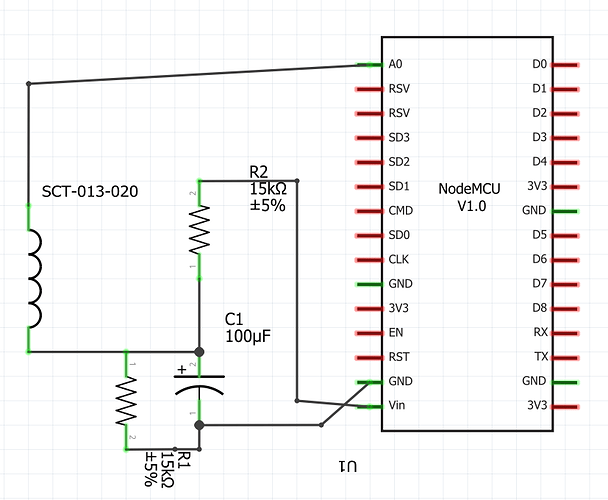Hi,
I want to use a SCT013 20A/1V with an ESP8266.
the wirering is illustrated here:
my problem is, if I attach the sensor to a powerline (of course only one of the three wires) which has a momentary load of 35W I got as an result 80W.
If I disconnect the wire to the sensor, it drops to 0. So the wirering itself should be ok.
If I raise the load the 80W increases too.
So, what could be wrong?
#include <SPI.h>
#include <EmonLib.h>
#define ANALOG_INPUT_SENSOR A0 // The digital input you attached your SCT sensor. (Only 2 and 3 generates interrupt!)
//#define INTERRUPT DIGITAL_INPUT_SENSOR-2 // Usually the interrupt = pin -2 (on uno/nano anyway)
EnergyMonitor emon1;
long wattsum = 0;
double kwh = 0;
double wh = 0;
long lastmillis = 0;
int minutes = 0;
void setup()
{
Serial.begin(115200);
emon1.current(ANALOG_INPUT_SENSOR, 25); // Current: input pin, calibration.
}
void loop()
{
if (millis()-lastmillis > 5000) {
double Irms = emon1.calcIrms(1480); // Calculate Irms only
if (Irms < 0.3) Irms = 0;
long watt = Irms*240.0;
wattsum = wattsum+watt;
minutes = minutes + 1;
lastmillis = millis();
Serial.print(watt); // Apparent power
Serial.print(" ");
Serial.println(Irms); // Irms
}
if (minutes == 10) {
wh = wh + wattsum/10;
kwh = wh/1000;
wattsum = 0;
minutes = 0;
}
}
Of course, I am new to this stuff 
